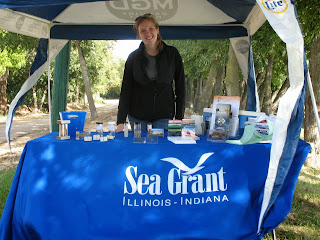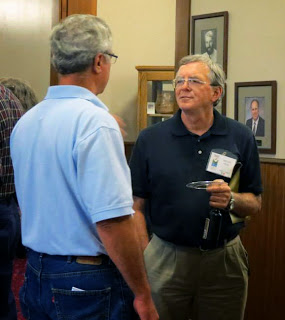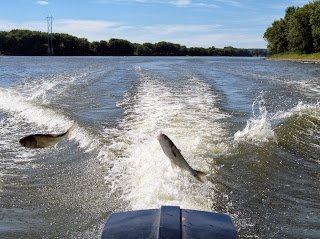October 9th, 2013 by Irene Miles
This past summer’s B-WET workshop offered a lot of lesson and activity ideas for all of the teachers who attended, including Marea Spentzos-Inghram, middle school teacher at Catherine Cook School in Chicago.
Beyond just taking a few curriculum ideas back to her lesson prep, though, Ms. Spentzos-Inghram decided to turn her class into student scientists by becoming official precipitation observers for CoCoRaHS – the “Community Collaborative Rain, Hail, and Snow Network” – which is a volunteer network of weather watchers throughout the country. The project was even featured in the school newsletter (photo below).
“The B-WET workshop presented teachers with so much information it would be impossible to not get inspired!” said Ms. Spentzos-Inghram. “They had a lineup of AMAZING presenters from a variety of organizations to promote their efforts, which made it a one-stop shop for information about bringing Great Lakes science into the classroom.”
“Being an urban school, I felt limited in outdoor environmental opportunities but CoCoRaHs was do-able. Since I have rooftop access to my building it was easy to participate! And the students get REALLY excited when it rains because they want to see how much rain fell at our school. I can’t imagine what it will be like for snow (or other precipitation).”
Ms. Spentzos-Inghram has expanded on this experience and introduced an outreach component, with a group of students working on a PSA right now featuring a cartoon rain gauge being interviewed.
As for the benefits of the workshop, “what they had to share seemed easy (teachers like easy) yet practical, useful, and educational. And the students have really taken to it and gotten involved, which is the best part of coming back with new ideas for the classroom.”
Similar workshops are held regularly, and you can contact IISG’s Robin Goettel and Terri Hallesy for more details. You can find additional information about Great Lakes science resources and training at our education page and at the Center for Great Lakes Literacy.
October 7th, 2013 by Irene Miles
Among the many Areas of Concern (AOCs) designated by the International Joint Commission, Illinois-Indiana Sea Grant has been involved in several providing research and reports on local stakeholders perceptions of cleanup operations and ways in which they are affected by the projects. This latest report details the St. Louis River AOC.
From IISG’s Caitie McCoy:
“A report on stakeholder perceptions of the St Louis River Area of Concern (AOC) and attitudes toward the cleanup and restoration work is now available. This summer, I traveled to the St Louis River with my intern Emily Anderson to perform social science research on community attitudes toward remediation and restoration. The river is located on the border between Duluth, MN and Superior, WI, and is the largest U.S. AOC. The report will help tailor efforts of the Spirit Lake Outreach Team toward local stakeholder needs and interests at the current Great Lakes Legacy Act site in the river, Spirit Lake.
Emily provided her thoughts on the experience – ‘Being part of the research team for this project allowed me to experience firsthand how social science contributes to environmental remediation and restoration. Conducting the interviews with Caitie, I met so many intriguing and knowledgeable people; I now see the direct implications that stakeholder input can have for both outreach and project design.’
This assessment is part of a larger effort to understand how AOC work influences stakeholder perceptions and use of waterways at a regional scale. A similar report on the Sheboygan River is available and a follow-up report on Sheboygan, post-cleanup, is coming soon.”
October 3rd, 2013 by Irene Miles
Alice Denny, a recent graduate from Hartwick College, spent the summer working with the Illinois-Indiana Sea Grant aquatic invasive species team in Glencoe, Illinois, and wrote in to share details about her experience.
“I’ve always had a love for being outdoors. Several family members of mine work in the environmental field, so that helped spark my interest in biology and environmental science. A relative of mine mentioned the IISG internship program to me last summer, but I was away at school and unavailable. I was very thankful that this internship was offered again this year as I finally got the chance to get involved with Sea Grant.
I worked with the Aquatic Invasive Species Outreach Team in Glencoe, IL. Specifically I worked with fishing tournament anglers and organizers, helping that group prevent the spread of aquatic invasive species. Anglers are a large and crucial audience when trying to reach recreational water users, as they are dependent on healthy water for fishing. However, little information was available on this audience and what they do in terms of AIS prevention. I conducted a survey with tournament organizers to better understand what their role was in AIS prevention, and I attended several fishing tournaments throughout the summer to conduct public outreach.
 I’ve gained so much more experience with public outreach and education through this internship. Going to events throughout the summer has provided me with experience explaining complex environmental issues to the public. I’ve always had an interest in ecology, but this internship has really fueled an interest in aquatic ecology, especially in the Great Lakes region. The Great Lakes are an important natural resource for us, and my internship gave me an opportunity to help protect the Lakes in a meaningful way.
I’ve gained so much more experience with public outreach and education through this internship. Going to events throughout the summer has provided me with experience explaining complex environmental issues to the public. I’ve always had an interest in ecology, but this internship has really fueled an interest in aquatic ecology, especially in the Great Lakes region. The Great Lakes are an important natural resource for us, and my internship gave me an opportunity to help protect the Lakes in a meaningful way.
At this point, I want to continue working in the environmental field before going back to school for any graduate work. At the moment, I’ve just been hired to continue with IISG as an outreach assistant. I’m obviously extremely excited to stay on board with the AIS team and continue working with recreational water users as well as other audiences critical to preventing the spread of these species.”
Alice is one of four interns who worked with IISG this past summer, and we’ll be featuring posts from the others coming up in future blog posts.
September 26th, 2013 by Irene Miles
Michigan Radio’s Here and Now recently discussed the issue of Asian carp and the State of Michigan’s preparations to prevent and fight the spread of the invasive fish.
From WBUR:
“Asian carp, an invasive and destructive fish, have spread through the Mississippi, Ohio, Illinois and Missouri rivers. In total, the fish are affecting more than 20 states from Louisiana to South Dakota.
Under the right conditions, it could take as few as a dozen Asian carp to establish a population in the Great Lakes. That’s according to a report published this month by scientists in Ontario.
If they’re correct, the risk of even just a handful of Asian carp escaping into the Great Lakes could be more significant than officials had planned.
From the Here & Now Contributors Network, Lindsey Smith of Michigan Radio reports on how the Department of Natural Resources in Michigan is getting ready to face off with this invader.”
Listen to the program or read the transcript at the link above.
September 25th, 2013 by Irene Miles
The Purdue University Department of Forestry and Natural Resources (FNR) celebrated their centennial anniversary from September 20-22, and included back-to-class sessions, tours of FNR buildings including the aquaculture research laboratory, and a Saturday evening banquet. More than 250 guests, including many FNR alumni, joined in the celebrations.
 FNR has spent the past 100 years training professional foresters, fishery and wildlife scientists, and natural resource managers who help to preserve and protect environmental resources throughout the country.
FNR has spent the past 100 years training professional foresters, fishery and wildlife scientists, and natural resource managers who help to preserve and protect environmental resources throughout the country.
Illinois-Indiana Sea Grant (IISG) has proudly partnered with FNR for more than 30 years. Brian Miller, IISG Program Director, said, “The Illinois-Indiana Sea Grant College Program highly values our 30 year partnership between NOAA, Purdue University, and the University of Illinois. This type of bi-state partnership only works in one other Sea Grant college in the country, and only works because of the mission-driven spirit of collaboration that exists on both of our campuses. The innovation, dedication and creativity of FNR have helped make the Illinois-Indiana Sea grant college program successful and enabled us to achieve positive impacts for local communities and the Great Lakes ecosystem.”

Recent IISG work was showcased during a welcome reception Friday night, and IISG staff assisted in organizing several of the celebration events throughout the weekend. Numerous current IISG staff members have worked closely with FNR, including Miller, Angela Archer, Carolyn Foley, Tomas Hӧӧk, Kwamena Quagrainie, and Kara Salazar, and the partnership continues to offer a crucial link in protecting coastal areas and waterways.
*Photos courtesy the FNR Centennial Committee
September 20th, 2013 by Irene Miles
Recent research in the Chicago area shows that bacteria are developing a resistance to a common antibacterial chemical used in many household and personal care products.
From The Cary Institute:
“Invented for surgeons in the 1960s, triclosan slows or stops the growth of bacteria, fungi, and mildew. Currently, around half of liquid soaps contain the chemical, as well as toothpastes, deodorants, cosmetics, liquid cleansers, and detergents. Triclosan enters streams and rivers through domestic wastewater, leaky sewer infrastructure, and sewer overflows, with residues now common throughout the United States.
Emma Rosi-Marshall, one of the paper’s authors and an aquatic ecologist at the Cary Institute of Ecosystem Studies in Millbrook, New York explains: ‘The bacterial resistance caused by triclosan has real environmental consequences. Not only does it disrupt aquatic life by changing native bacterial communities, but it’s linked to the rise of resistant bacteria that could diminish the usefulness of important antibiotics.'”
Read more about this recent research and some of the implications of these antibacterial compounds at the link above.
September 19th, 2013 by Irene Miles
Illinois-Indiana Sea Grant’s Caitie McCoy and others have just completed work on a new curriculum for elementary and high school science students.
Helping Hands: Restoration for Healthy Habitats offers lessons and hands-on activities to connect students in the Great Lakes with recent or ongoing cleanup and restoration projects happening in their communities. The range of activities offers new ways to engage students with real-life examples that show environmental science in action.
Teachers interested in having Sea Grant lead the curriculum in their school should contact Caitie McCoy. Caitie can work with the teacher to customize curriculum to meet school-specific needs. The curriculum expands Great Lakes literacy among students, many of whom may become future researchers and educators.
Community leaders in Areas of Concern that would like to help Sea Grant lead or set up an educational program are also encouraged to contact Caitie. The complete curriculum is free to download at the link above.
September 16th, 2013 by Irene Miles
Recent research indicates that even a handful of Asian carp, between just ten and twenty fish, could establish an ecologically damaging population in the Great Lakes.
From ScienceDaily.com:
“Published this week in the Biological Invasions journal, research from Professor Kim Cuddington of the Faculty of Science at Waterloo indicates that the probability of Asian carp establishment soars with the introduction of 20 fish into the Great Lakes, under some conditions…
‘This species will have a huge impact on the food web,’ says Professor Cuddington. ‘Not only is it a fast-growing fish physically, but the population itself grows very quickly. A female can lay well over a million eggs a year, and with no known predators present in the Great Lakes, the Asian carp could dominate the waters and impact fisheries.’…
Individual fish have already been caught in two of the Great Lakes. The probability of Asian carp establishment changes dramatically if only 10 of the creatures are introduced. With 10 fish, the probability of a population of Asian carp is only 50 per cent, but with 20 fish, it jumps to 75 per cent, under some conditions.”
September 12th, 2013 by Irene Miles
IISG staff will have the opportunity to see aquaculture in action next week while touring the Bell Aquaculture facility in Albany, IN. IISG’s Kwamena Quagrainie has been studying and providing expert advice to aquaculture operations in the Midwest and worldwide for many years, and will be giving the staff more information on how the facility provides millions of pounds of sustainably grown fish to the market each year.
Aquaculture has been a growing food field in the state of Indiana, and a recent feasibility study funded in part by IISG (available online soon at our research projects page) shows that it may have significant potential in Illinois as well.
Additionally, Purdue University produced this great video about aquaponics, which is an extension of aquaculture where fish and plants are raised sustainably and simultaneously in a mutually beneficial system.
Learn more about aquaculture on our aquaculture page.





